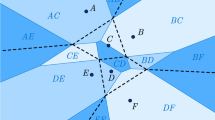Abstract
A new point process is proposed which can be viewed either as a Boolean cluster model with two cluster modes or as a p-thinned Neyman-Scott cluster process with the retention of the original parent point. Voronoi tessellation generated by such a point process has extremely high coefficients of variation of cell volumes as well as of profile areas and lengths in the planar and line induced tessellations. An approximate numerical model of tessellation characteristics is developed for the case of small cluster size; its predictions are compared with the results of computer simulations. Tessellations of this type can be used as models of grain structures in steels.
Similar content being viewed by others
References
V. Horálek: ASTM grain size model and related random tessellation models. Materials Characterization 25 (1990), 263–284.
J. Møller: Random Johnson-Mehl tessellations. Adv. in Appl. Probab. 24 (1992), 814–844.
J. Møller: Lectures on Random Voronoi Tessellations. Lecture Notes in Statistics 87. Springer-Verlag, New York, 1994.
A. Okabe, B. Boots and K. Sugihara: Spatial Tessellations. J. Wiley & Sons, Chichester, 1992.
P. Ponížil, I. Saxl: Grain size estimation II: Other models, variances. In: STERMAT' 2000, Proceedings of the Sixth Int. Conf. “Stereology and Image Analysis in Materials Science” (L.Wojnar, K. Ro´zniatowski, eds.). Polish Society for Stereology, Cracow, 2000, pp. 379–384.
I. Saxl, P. Ponížil: 3D Voronoi tessellations of cluster fields. Acta Stereol. 17 (1998), 237–246.
I. Saxl, P. Ponížil: 3D Voronoi tessellations generated by Poisson and lattice of cluster fields. Acta Stereol. 17 (1998), 247–252.
I. Saxl, P. Ponížil: Random tessellations: Stochastic simulations and applications. Proceedings of the workshop “Programs and Algorithms of Numerical Mathematics”, Libverda 2000. Mathematical Institute of the Academy of Sciences of the Czech Republic, Praha, 2000, pp. 150–161.
I. Saxl, K. Sülleiová and P. Ponížil: 3D simulations of intergranular fracture. In: Proceedings of the International Conference “Fractography 2000”, Vysoké Tatry, 15–18.10.2000 (L. Parilák, ed.). Inst. Mat. Res., Slovak Acad. Sci., Košice, 2000, pp. 94–107.
I. Saxl, K. Sülleiová and P. Ponížil: Simulating grain size estimation. Metallic Materials 39 (2001), 396–409.
D. Stoyan, W. S. Kendall and J. Mecke: Stochastic Geometry and its Applications. J. Wiley & Sons, New York, 1995.
D. Stoyan, H. Stoyan: Fractals, Random Shapes and Point Fields. J. Wiley & Sons, Chichester, 1994.
A. Ševůík, K. Sülleiová, M. Besterci, I. KohÚtek and I. Saxl: Grain size estimation in steels. Metallic Materials 40 (2002),in press.
G. F. Vander Voort: Grain size measurement. In: Practical Applications of Quantitative Metallography. ASTM STP 839, ASTM, Philadelphia, 1982, pp. 85–131.
O. Velgosová, I. Saxl and M. Besterci: Microstructural characteristics of dispersion strengthned Cu-based system. In: Proc. 3rd International Conference “Materials Structure & Micromechanics of Fracture” (P. Šandera, ed.). Vutim, Brno University of Technology, 2001, pp. 223–231, CD ROM.
Author information
Authors and Affiliations
Rights and permissions
About this article
Cite this article
Saxl, I., Ponizil, P. Bernoulli Cluster Field: Voronoi Tessellations. Applications of Mathematics 47, 157–167 (2002). https://doi.org/10.1023/A:1021737219136
Issue Date:
DOI: https://doi.org/10.1023/A:1021737219136




